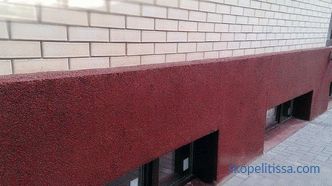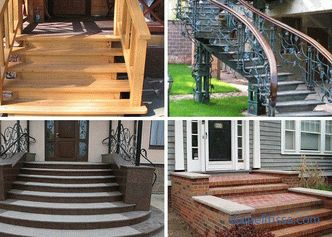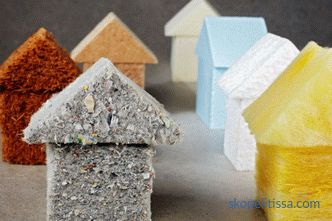Relaxing by the water, especially in the summer heat - this is one of the proven ways to relieve nervous tension and forget about the immediate problems. But if the sea is far away, then this problem will be solved by a pond in the country. The article tells about the types of artificial reservoirs for a country house, the choice of their optimal size and stages of work on the arrangement. After reading the article you will also learn about the nuances of the design of the dacha pond and what will be needed to care for the pond.
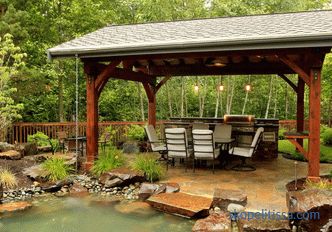
Pond in the country: varieties
The pond in the area may vary in size and shape. The technology of arranging an artificial reservoir in turn depends on them. A small and uncomplicated object can be obtained by digging into any container: bath, barrel, plastic container, car tire with lined film, etc. In addition, you can find ready-made decorative plastic molds on sale. Large volumes of reservoirs are created using durable waterproof PVC film or butyl rubber. The most laborious and expensive to build is a pond with a concrete base.
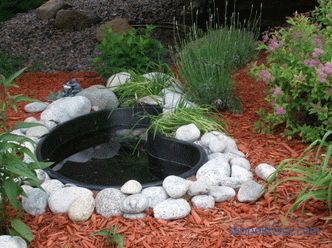
Water bodies can be single-level (with a flat bottom) or multi-level. Water in them can be in a standing state or circulate and be cleaned due to the operation of a pressure pump and filters.
Optimum size and location
An artificial pond in a country house has an optimal size if its area corresponds to the area of a plot. It should not be too large, but not too miniature. In the latter case, the situation can be corrected by equipping one more reservoir nearby and installing a bridge at the point of contact of the ponds. This will create the effect of the unity of the water surface.
When determining the location of a reservoir, the following factors should be taken into account:
-
illumination of the site;
-
location of trees and shrubs;
-
availability of beaches for the approach;
-
location recreation areas;
-
visibility of the pond from the windows of the house, from the street;
-
slope and the relief of the site.
How to equip a reservoir
The technology for arranging a bowl of a reservoir at a dacha depends on the type of pond. A common stage for all types of ponds is the digging and preparation of a pit with a different volume of earthworks. After installing the bowl proceed to decorating her environment.
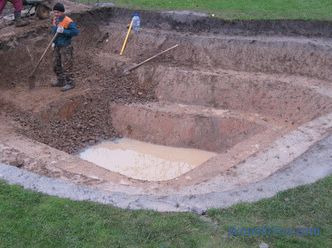
The technology of arranging the reservoir from the finished plastic form
Under the decorative pond in the country a trench is dug, similar to the contours of the bottom of the plastic form. It should be slightly larger than the plastic insert, the depth should be the same or slightly less. Deepening below the surface of the site will further lead to the flow of dirty water into the pond during the rain.
When the required depth is reached, the bottom of the excavation is leveled with a spade and bar. The main goal is to get a flat surface with respect to the horizon. If the composition of the soil (clay, peat, etc.) does not allow this, then an additional 5-10 cm of soil is removed, and a layer of sand is laid instead.
After preparing the pit, a plastic container is placed into it; if the bottom is aligned correctly, then the edges of the container will be set exactly on the horizon. The finishing operation is backfilling with the tamping of voids between the walls of the cup and the pit.
How a pond is created using a film
First, a pond sketch is created. It defines all the geometric parameters of the reservoir, including the parameters of curtain - protrusions intended for planting aquatic plants. On the sketch, it is desirable to determine the placement of decorative elements (stones, flowers or trees in pots, sculptures, islands). Marking the boundaries of the pit directly on the site by using a cord or spray paint. After marking the turf is removed.
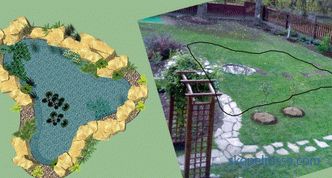
When the turf is removed and removed, they start digging the pit. If a multi-level reservoir is planned, then the digging of the pit is carried out in stages. First, the earth layer is removed to the first mark, the borders of the deeper part of the reservoir are marked and the next layer is removed, etc. If a deep pond is planned in which the fish will live, then the depth of the pit can be up to 2 meters or more.
In parallel with the digging, the removal of dirty slurry, which may appear as a result of rain, is carried out.The slope of the walls, horizontal banks and the bottom are set at the level. Additional difficulties may arise with loose soils or with the construction of large ponds. In this case, reinforcement of the pit walls (concreting, laying bricks) will be required.
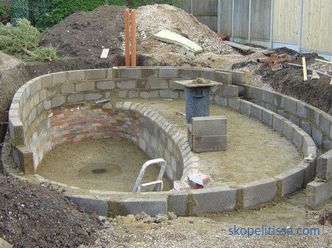
A dug ditch is examined for sharp stones sticking to the roots. They must be removed. The bottom of the pit is filled with sand in a layer of 15 cm (with tamping) and lined with geotextile or roofing material. This will provide drainage, prevent shrinkage of the base of the reservoir and protect the waterproofing from damage by rodents and germinating plants and their roots.
For laying a waterproofing film around the perimeter of the pit, a moat with a depth of 0.2 meters is dug. It will be fixed material from PVC or butyl rubber. The required film size is determined with the help of ropes lining the bottom of the pit. To fix the waterproofing material, an additive of 50 cm is required relative to the measured geometrical parameters. To obtain the desired size of the laid piece may need to spike a few two or more strips of material.
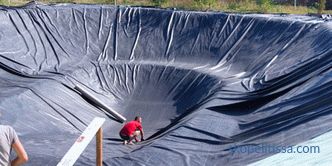
The cut piece of waterproofing is spread to the bottom of the pit, edges are pressed by bricks or stones . Then the reservoir is filled with water. After a day, when under the influence of water pressure the film completely fills the volume of the pit, its surplus is cut off. The edges are laid in a trench, which is filled with rubble.
Concrete structures
Very large ponds in terms of volume are, in fact, pools located in the open air. For their construction will need to dig and prepare the pit. It cast from heavy concrete with plasticizers, reinforcement and installation of mortgages (plums, nozzles, etc.) bowl of the reservoir.
It may be interesting! In the article on the following link read about the pools on the site of a country house - their varieties, design and cost.
Making the shores and interior of the bowl
To give the pond an attractive appearance, before filling it with water, the edge of the pond is lined with natural stone, crushed stone, stone boulders, pebbles are laid on the bottom, and plastic curtains are placed on the bottom tanks with transplanted aquatic plants. For medium and large bodies of water, the shore arrangement includes the installation of log flooring and bridges.
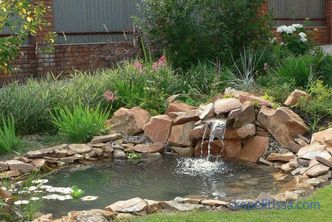
To prevent water stagnation, an artificial stream is often created, even with small waterfalls. Water into its source is supplied by a submersible pump through a filter directly from the pond.
Plants for a reservoir are chosen taking into account their functional qualities. These are oxygen generators, they carry out biological water purification and are food for fish and decorative (deep-water, embankments and floating). Making ponds today is considered an art, which already stands out the whole areas of design: Chinese, Italian, French, Japanese and English.
It may be interesting! In the article on the following link read about the arrangement of swimming pool sites - the technology and stages of work.
How to care for a pond
In the spring, when a reservoir starts operating, it is necessary to clean its banks, walls and bottom from debris accumulated during the fall and winter. In the same period, planting of annual plants is carried out. For ground cleaning you will need a special vacuum cleaner. Water quality should be monitored periodically by test indicators.
In the summer, it is necessary to remove garbage falling on it from the surface of the water, this is done with the help of a skimmer (filter for the pool). Also during this period, you need to remove the emerging filamentous algae. If oxygen-generating plants do not sufficiently purify water, which provokes the reproduction of green algae, then it will be necessary to use chemicals - algaecides.
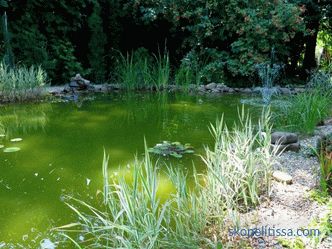
For water lilies and irises, fertilizing is necessary. Tropical plants in a pond are placed only in summer, and during cold time they are moved into containers with water, which are cleaned into rooms with a temperature that is favorable for vegetation.
In autumn, when the leaves are falling, it is recommended to close the water surface with a fine net. This is done to prevent fallen leaves from falling to the bottom and not starting to rot there. In winter, the pond water is drained, the pumps and filters are removed and cleaned. The exception is small ponds of plastic molds; draining water from them can lead to container deformation.
Beautiful pond design ideas on the summer cottage in the video:
On our website you can find contacts of construction companies that offer design and work services on arrangement of reservoirs and other turnkey landscape elements. Directly to communicate with representatives, you can visit the exhibition of houses "Low-rise Country".
Summing up
Arrangement and operation of a garden pond is a process that requires not only technical knowledge, but also knowledge and understanding of processes in the field of biology. Competences in the field of landscape design are also required. All this together can be found in specialized companies engaged in the creation of ponds professionally.
